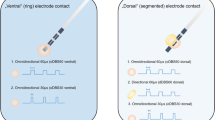Abstract
Deep brain stimulation (DBS) has become an important option for medication-refractory essential tremor (ET), but may contribute to worsened gait and falling. This study evaluates impaired gait in a cohort of patients treated with DBS with a retrospective review of ET patients before and after DBS implantation. Factors examined included: age, duration of symptoms, pre-morbid gait difficulties/falls, Fahn-Tolosa-Marin tremorrating scale (TRS) scores at baseline, 6 months post-unilateral DBS implantation, and 6 or 12 months post-bilateral implantation. All implantations targeted the nucleus ventralis intermediate (Vim). Thirty-eight patients (25 males, 13 females) were included. Twenty-five patients (65.8%) underwent unilateral DBS implantation and 13 (34.2%) bilateral. The mean age at surgery was 67.1 years ± 11.4 (range 34–81). The mean disease duration was 31 years ± 18.3 (range 6–67). Fifty-eight percent of patients had worsened gait post-operatively. Seventy percent of patients with unilateral Vim DBS experienced gait worsening while 55% of bilateral DBS patients experienced gait worsening. Patients with worsened gait post-DBS had higher baseline pre-operative TRS scores than those without worsened gait (43.1 points ± 8.4 vs. 33.1 points ± 10.1, p = 0.002) (odds ratio 2.5, p = 0.02). Gait/balance may worsen following DBS for medication refractory ET. Higher baseline TRS score may factor into these issues, although a larger prospective study will be required with a control population. The larger percentage of difficulties observed in unilateral versus bilateral cases likely reflected the bias to not proceed to second-sided surgery if gait/balance problems were encountered.

Similar content being viewed by others
References
Charles PD, Esper GJ, Davis TL, Maciunas RJ, Robertson D (1999) Classification of tremor and update on treatment. Am Fam Physician 59(6):1565–1572
Bove M, Marinelli L, Avanzino L, Marchese R, Abbruzzese G (2006) Posturographic analysis of balance control in patients with essential tremor. Mov Disord 21(2):192–198
Koller WC, Pahwa PR, Lyons KE, Wilkinson SB (2000) Deep brain stimulation of the Vim nucleus of the thalamus for the treatment of tremor. Neurology 55(12 Suppl 6):S29–S33
Stolze H, Petersen G, Raethjen J, Wenzelburger R, Deuschl G (2001) The gait disorder of advanced essential tremor. Brain 124(11):2278–2286
Pahwa R, Lyons KE, Wilkinson SB et al (2006) Long-term evaluation of deep brain stimulation of the thalamus. J Neurosurg 104:506–512
Earhart GM, Clark BR, Tabbal SD, Perlmutter JS (2009) Gait and balance in essential tremor: variable effects of bilateral thalamic stimulation. Mov Disord 24(3):386–391
Resnick AS, Foote KD, Rodriguez RL et al (2009) The number and nature of emergency department encounters in patients with deep brain stimulators. J Neurol 257(1):122–131
Fasano A, Herzog J, Raethjen J et al (2010) Gait ataxia in essential tremor is differentially modulated by thalamic stimulation. Brain 133(Pt 12):3635–3648
Morishita T, Foote DK, Wu SS et al (2010) Brain penetration effects of microelectrodes and deep brain stimulation leads in ventral intermediate nucleus stimulation for essential tremor. J Neurosurg 112(3):491–496
Conflict of interest
Dr. Hwynn, Dr. Hass, Mrs. Zeilman, Ms. Romrell, Mr. Dai, Dr. Subramony, Dr. Oyama, Dr. Velez-Lago, and Mr. Resnick report nothing to disclose. Dr. Wu received personal compensation from Bioness Inc. for consulting services and from the Journal of Physical Therapy for serving as a statistical reviewer. Dr. Foote has received Medtronic fellowship training and research grants and has participated in CME activities on movement disorders sponsored by the University of South Florida CME office. Dr. Fernandez received personal compensation for being Medical Editor of the Movement Disorders Society Website and financial support for research activities from: National Institute of Neurological Disorders and Stroke, Michael J. Fox Foundation, National Parkinson Foundation, Movement Disorders Society, Huntington Study Group, Acadia, AstraZeneca, Solvay Pharmaceuticals, and Teva Pharmaceuticals. Dr. Malaty has received grant support from the National Parkinson Foundation. Dr. Okun serves as a consultant for the National Parkinson Foundation, and has received research grants from the National Institutes of Health, National Parkinson Foundation, the Michael J. Fox Foundation, the Parkinson Alliance, Medtronic peer-reviewed fellowship training grants, and the UF Foundation. Dr. Okun has in the past received honoraria for Deep Brain Stimulation educational talks prior to 2010, but currently receives no support. Dr. Okun has received royalties for publications with Demos, Manson, and Cambridge (movement-disorders books). Dr. Okun has potential royalty interest in the COMPRESS tool for Deep Brain Stimulation. Dr. Okun has participated in CME activities on movement disorders sponsored by the University of South Florida CME office.
Author information
Authors and Affiliations
Corresponding author
Rights and permissions
About this article
Cite this article
Hwynn, N., Hass, C.J., Zeilman, P. et al. Steady or not following thalamic deep brain stimulation for essential tremor. J Neurol 258, 1643–1648 (2011). https://doi.org/10.1007/s00415-011-5986-0
Received:
Revised:
Accepted:
Published:
Issue Date:
DOI: https://doi.org/10.1007/s00415-011-5986-0




